 Mike Self
.
December 27, 2021
.
Department
.
Mike Self
.
December 27, 2021
.
Department
.
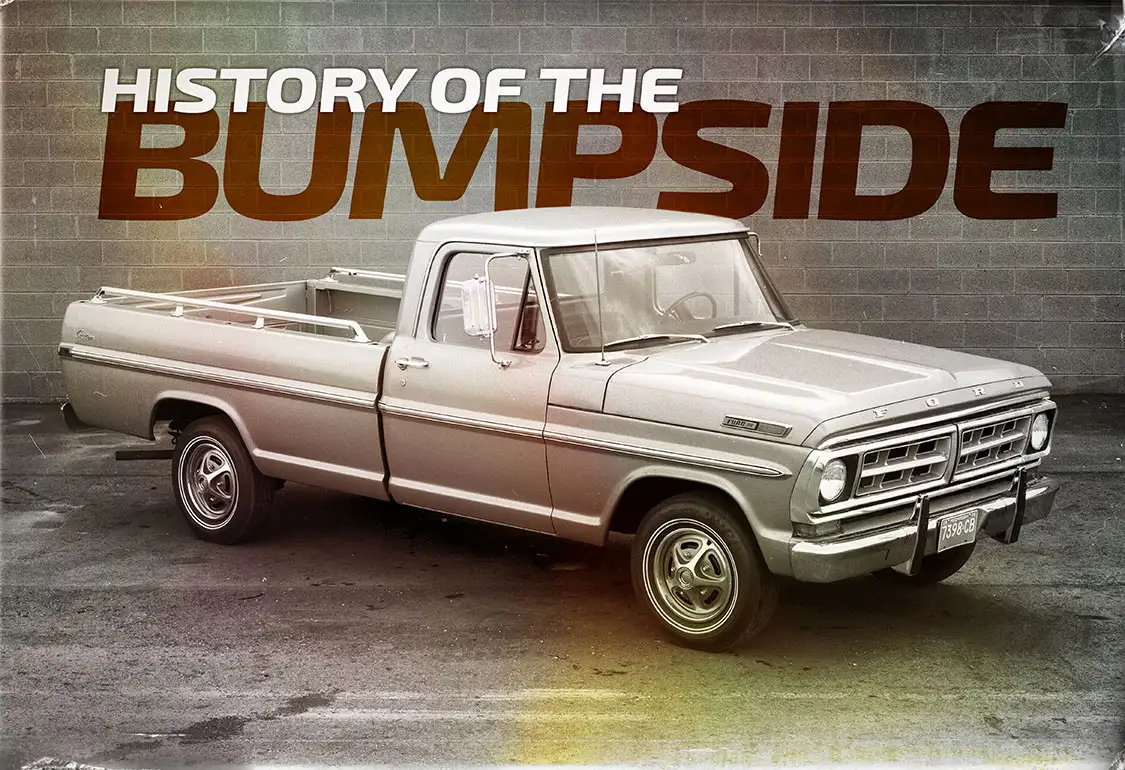
The year 1967 was an interesting one. The Vietnam War waged on, as did the anti-war protests amid the burgeoning “peace and love” movement of the late ’60s. The Doors’ self-titled album hits music store shelves, and Super Bowl I takes place, with the Green Bay Packers defeating the Kansas City Chiefs. In other football news, a rising star by the name of O.J. Simpson dazzles crowds as running back for USC, winning the Heisman Trophy the following year.
 A singer/actor by the name of Elvis marries Priscilla Beaulieu at the Aladdin Hotel in Las Vegas, and Loving v. Virginia is decided in the U.S. Supreme Court, overturning a conviction brought forth due to Virginia’s anti-interracial marriage laws.
A singer/actor by the name of Elvis marries Priscilla Beaulieu at the Aladdin Hotel in Las Vegas, and Loving v. Virginia is decided in the U.S. Supreme Court, overturning a conviction brought forth due to Virginia’s anti-interracial marriage laws.
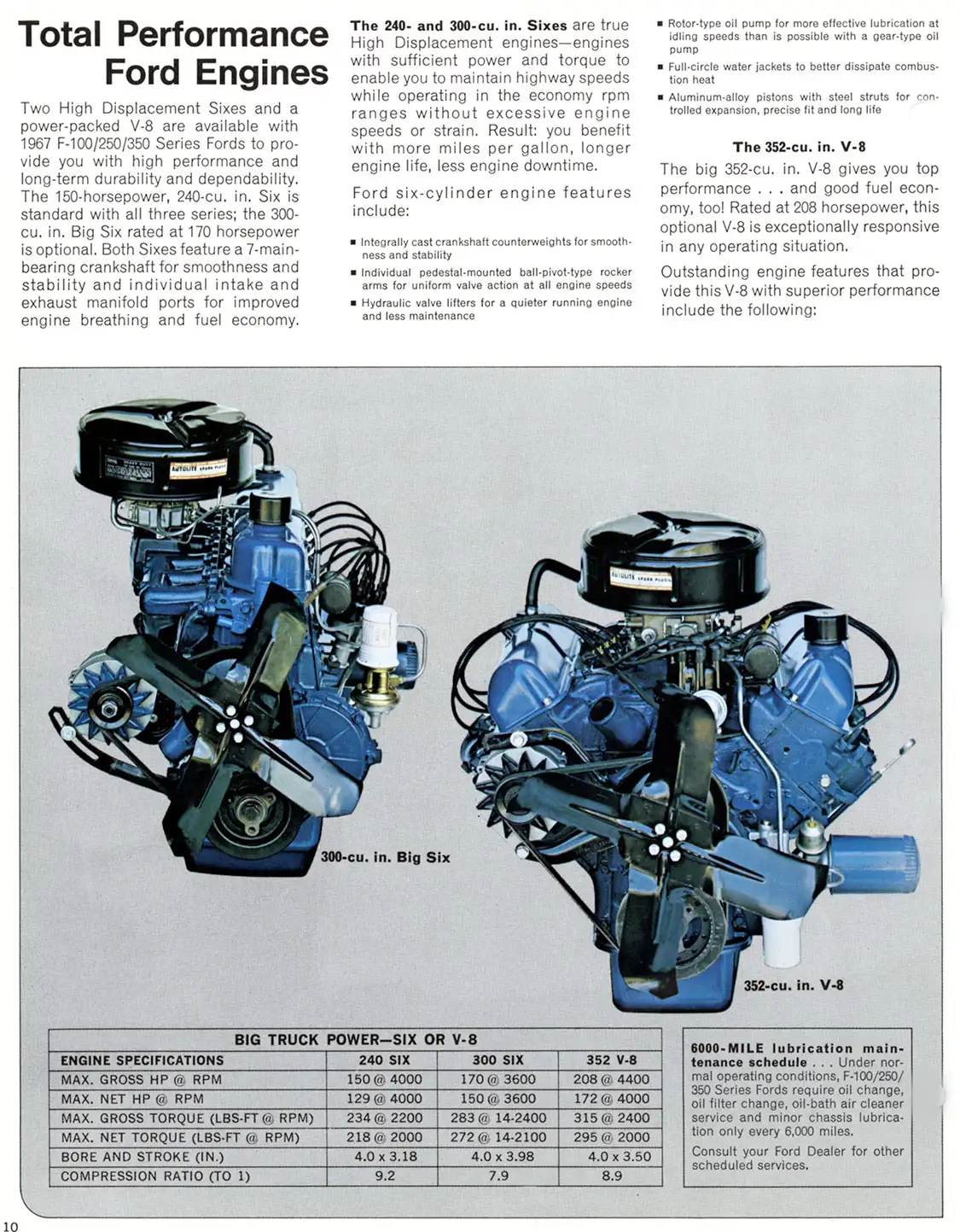 The Big Mac is introduced to the people of Pittsburg, and soon finds its way to McDonald’s restaurants nationwide. Kathrine Switzer, who has probably never had a Big Mac, runs the Boston Marathon as a registered competitor, despite women not being allowed to race according to its organizers (the official rulebook made no mention of gender). It would be five more years until Boston added a women’s race to the marathon.
The Big Mac is introduced to the people of Pittsburg, and soon finds its way to McDonald’s restaurants nationwide. Kathrine Switzer, who has probably never had a Big Mac, runs the Boston Marathon as a registered competitor, despite women not being allowed to race according to its organizers (the official rulebook made no mention of gender). It would be five more years until Boston added a women’s race to the marathon.
Meanwhile in Dearborn, Michigan, Ford had introduced its latest incarnation of the F-Series (How’s that for a smooth segue?). Based on the same chassis as the mechanically revamped ’65 F-Series, the new ’67s were a dramatic take on the future of Ford truck design. A sportier appearance and a pronounced “bump” in the beltline were the most obvious changes, but the interiors were also more car-like this go-around.
Trim packages consisting of Base, Custom Cab and Ranger started off the fifth-generation F-Series’ offerings, although trim names changed somewhat throughout the body style’s run. By the time 1970 rolled around, mid and top-level trim packages were renamed to Sport Custom and Ranger XLT.
In 1968, federal safety mandates required automakers to add side marker reflectors to their vehicles. In the case of Ford trucks, this was accomplished by adding reflectors to the hood and bedsides. Also in 1968 was replacement of the 352 FE with optional 360 and 390 FE engines (170, 240 and 300 cubic-inch I-6s were also available), and the 302 Windsor was also available from 1969-on. This was the first year, too, that one could order a Ford truck with factory air conditioning instead of having to get a third-party setup installed at the dealership. A popular option was the Camper Special, which added camper/trailer wiring, as well as heavy duty cooling and charging system upgrades.
The most drastic change to the fifth-gen trucks came in 1970, with completely a completely new grille design with incorporated wraparound signal lights, as well as changes to the body trim.
As per usual, styleside and flareside boxes were available across the line, and a 4×4 drivetrain was available on F-100 and F-250 models, meaning that no matter what one’s needs, there was a Ford truck that could do the job. Now, check out the rest of the story of Ford bumpside for some awesome photos and press releases from our friends at the Ford Motor Company Archives!

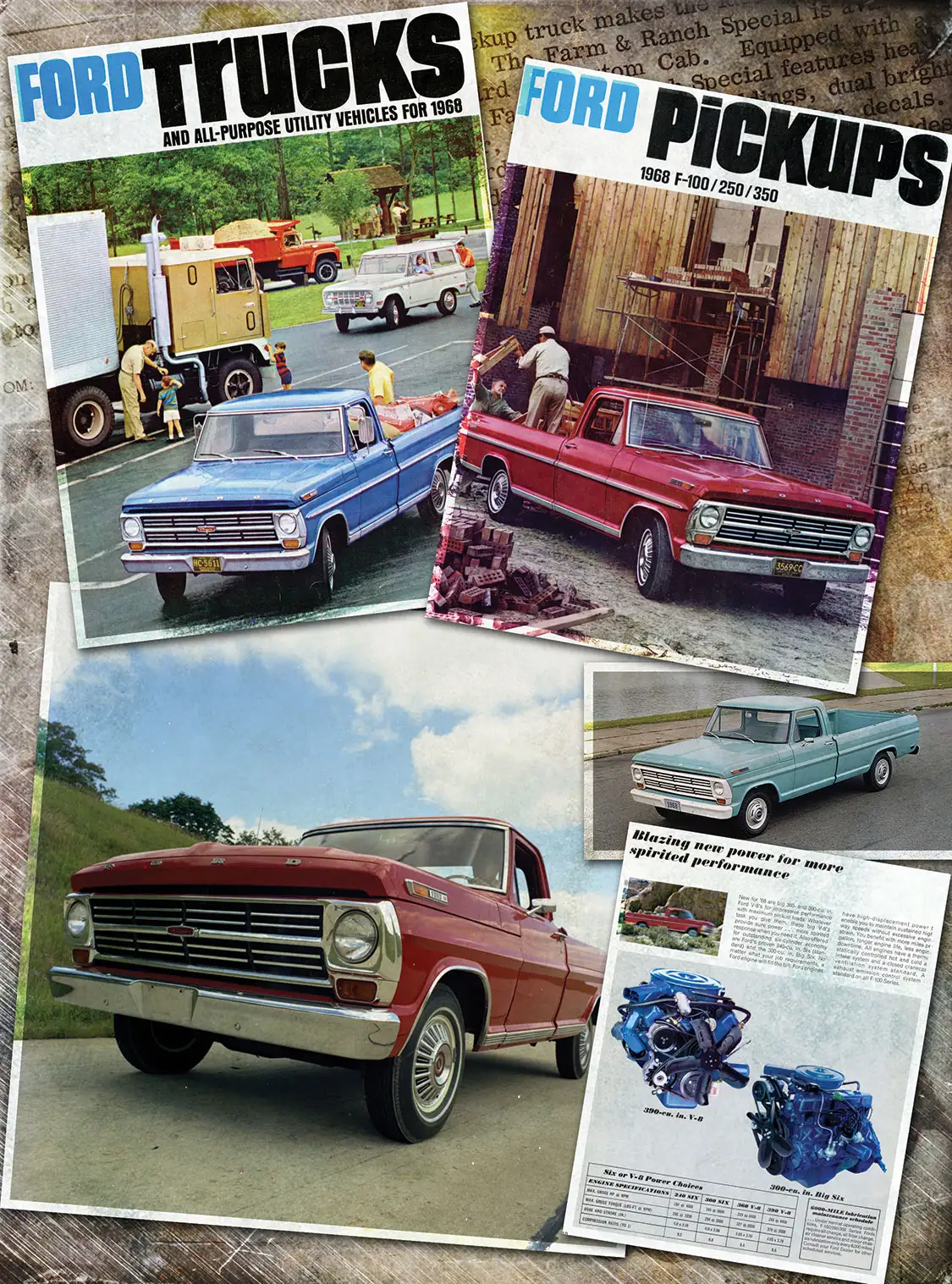
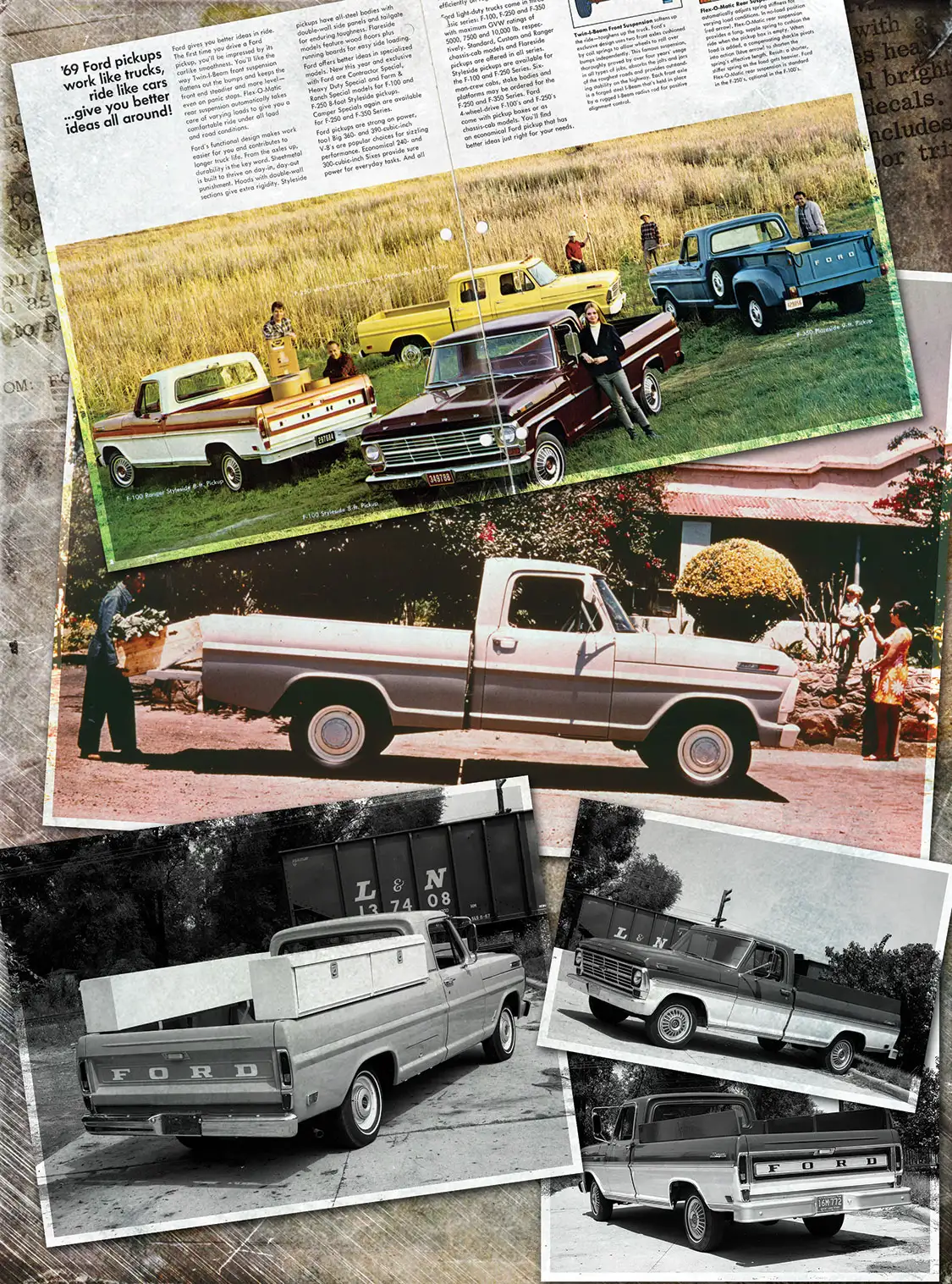

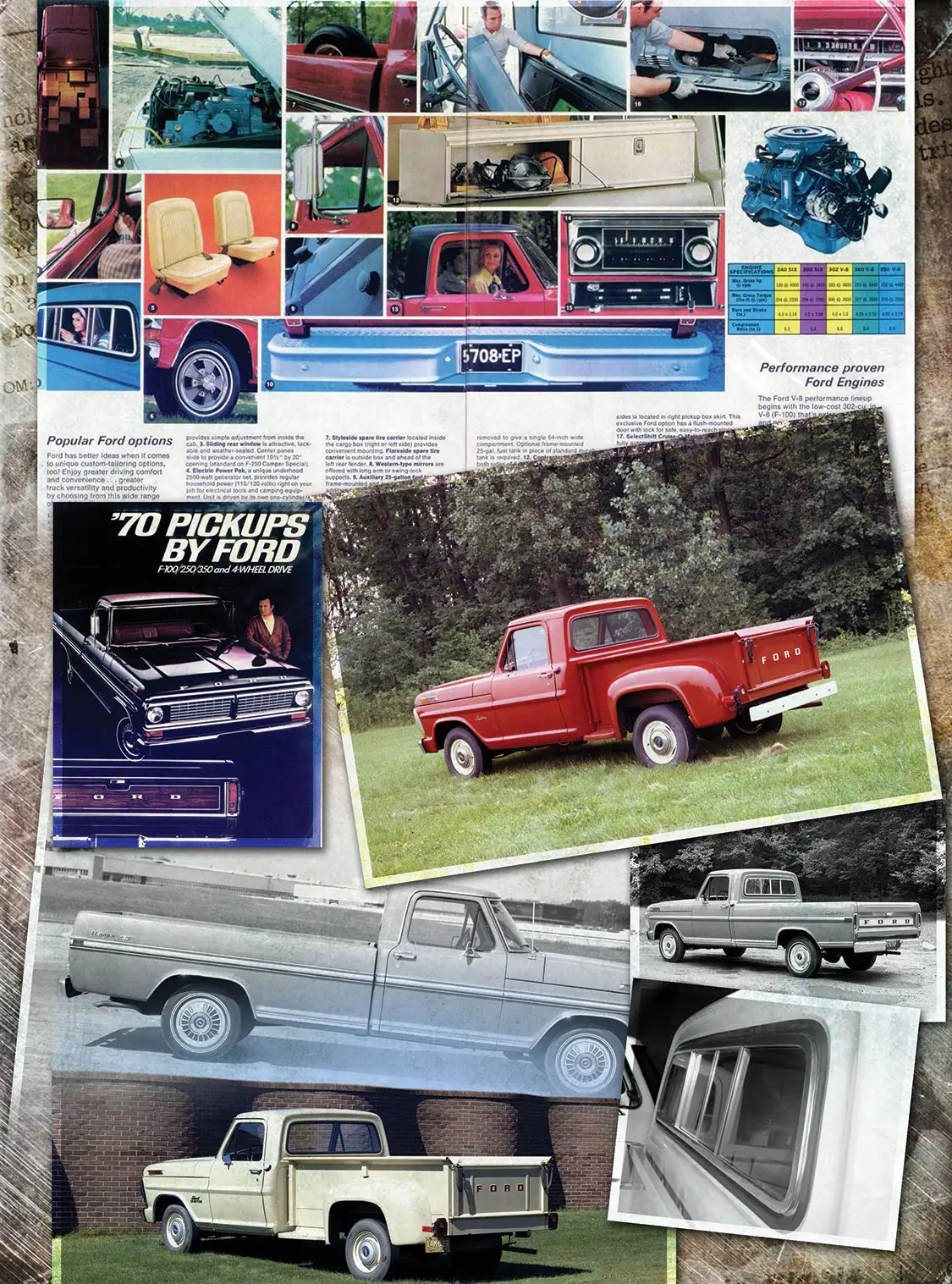
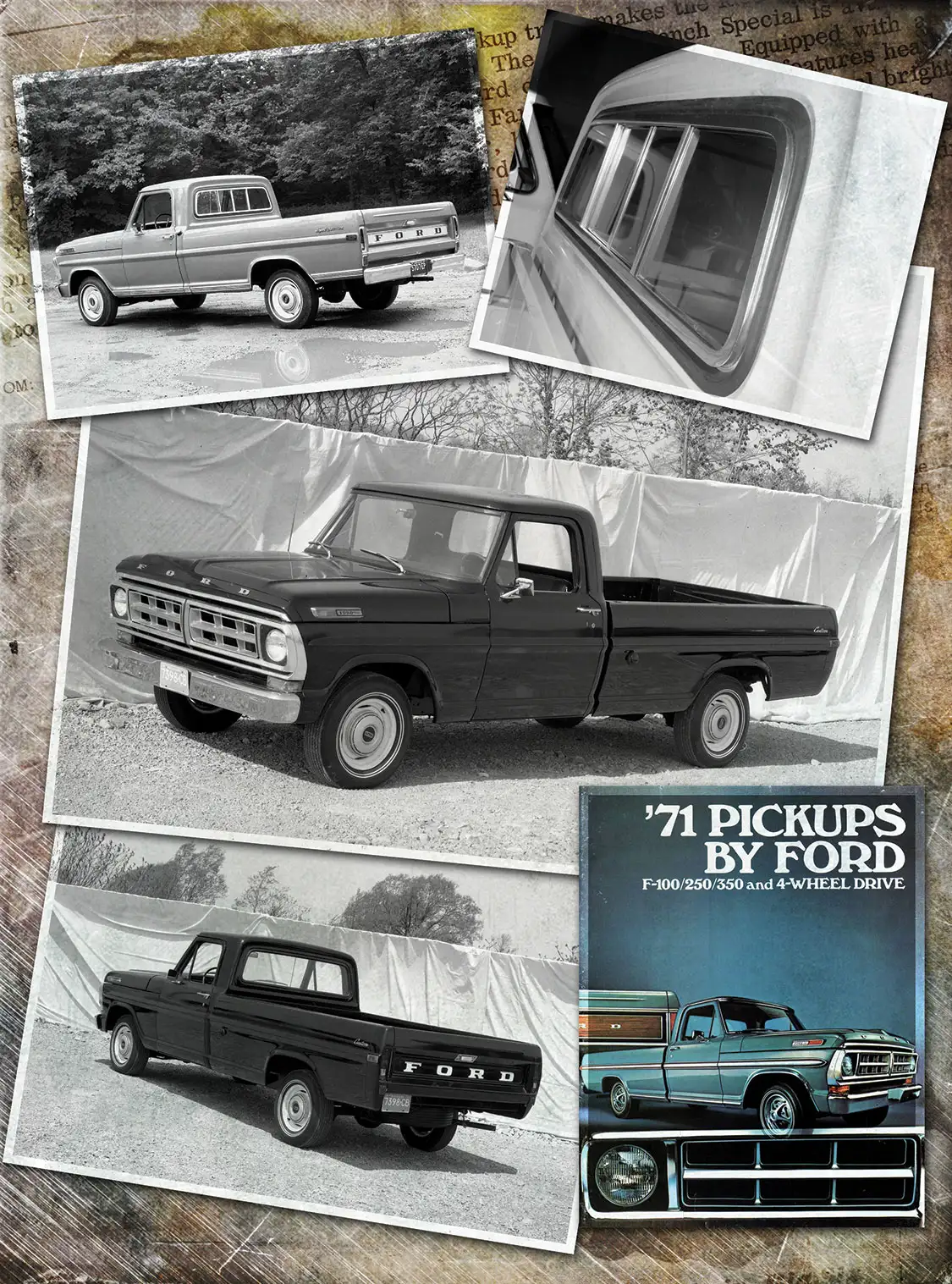

Read More: Complete History of the Ford F-Series Trucks
The 1967 Ford F-100 marked a significant evolution in the lineage of Ford’s light-duty trucks. At first glance, this model appeared entirely new, but it was built upon the foundation of its predecessors from 1961 to 1966, boasting fresh styling cues that set it apart. Key design elements included a striking horizontal crease bisecting the bodywork, angular wheel well openings, and a more detailed grille assembly. The truck was offered in several trim levels: standard cab, Custom Cab, and the upscale Ranger. Notably, 1967 also introduced the first factory-available crew cab, although this feature was limited to ¾-ton and larger pickups.
While the powertrain selection initially remained similar to the previous year’s, significant updates arrived in 1968. The old 352-cubic inch V-8 engine was replaced with new 360- and 390-cubic inch V-8 engines, designed on the FE (Ford-Edsel) architecture. These new engines provided better torque and overall performance. Additionally, the 1968 models complied with new U.S. regulations by including side marker reflectors, enhancing safety.
In 1969, the small-block 302 V-8 was added to the roster, broadening the engine options. By 1970, the F-100 received an updated grille design, and the Ranger XLT was introduced—a trim level that quickly gained popularity. The Ranger XLT featured luxurious touches like color-coordinated full carpeting, pleated cloth and vinyl seats, enhanced insulation, added chrome accents, and a wood-tone tailgate panel.
A special Explorer package debuted as a spring release, exclusively featuring bold Grabber Blue and Explorer Green paint options. For the 1971 model year, minor trim updates occurred, standardizing features like a chrome front bumper and a bright aluminum grille, phasing out painted grilles for basic models. The expanded trims included Custom, Sport Custom, Ranger, Ranger XLT, and the special Explorer.
The 1972 F-100 saw minimal changes before a new generation took over in 1973. Throughout this era, the F-100 continued to embody a shift towards more car-like features in light-duty trucks. Options now included power steering, power brakes, a simulated vinyl roof, remote control mirrors, AM/FM stereo radios, and factory-installed air conditioning. This progression underscored the F-100’s role in bridging the gap between utilitarian workhorses and comfortable, feature-rich vehicles, solidifying its historical significance in the evolution of American trucks.
The 1967-1972 Ford F-Series trucks have seen diverse interest in the market, varying from high-end auctions to more accessible sales. Below are the key figures that outline their historical performance:
These numbers illustrate a wide disparity in sale prices, reflecting differing conditions, models, and levels of restoration. The notable highest sale signifies that certain models, especially those in pristine condition or with historical significance, can command top-dollar amounts. Conversely, the most recent sale at a significantly lower price indicates that more common examples of this range are still accessible to collectors and enthusiasts.
In essence, the 1967-1972 Ford F-Series vehicles remain a dynamic presence in the automotive market, catering to a broad spectrum of buyers. Whether for investment, restoration, or everyday classic car enjoyment, these statistics provide an essential snapshot for potential buyers and enthusiasts alike.
When looking to buy a 1967 Ford F-100, understanding the different conditions and their corresponding values is essential. Here’s a breakdown:
The value of a 1967 Ford F-100 can significantly vary based on its condition and specific configuration. Whether you’re a classic car enthusiast or a potential buyer, understanding these categories and values will help make informed decisions. Regular market updates and alerts can keep you informed about key changes in these values.
The most drastic change to the fifth-gen trucks came in 1970, with a completely new grille design featuring incorporated wraparound signal lights. The introduction of the Ranger XLT trim level brought a host of new features, making it a standout model.
In 1968, Ford made significant changes to the powertrain options. The 352 FE engine was replaced with optional 360 and 390 FE engines, offering better performance and reliability. Additionally, the small-block 302 V-8 was added to the option list for 1969. This was also the first year Ford trucks could be ordered with factory air conditioning, a feature previously available only through third-party installations at dealerships. The popular Camper Special option included camper/trailer wiring, heavy-duty cooling, and charging system upgrades.
As per usual, styleside and flareside boxes were available across the line, and a 4×4 drivetrain was available on F-100 and F-250 models, meaning that no matter what one’s needs, there was a Ford truck that could do the job.
Now, check out the rest of the story for some awesome photos and press releases from our friends at the Ford Motor Company Archives!
Per usual, styleside and flareside boxes were available across the line, and a 4×4 drivetrain was available on F-100and F-250 models, meaning that no matter what one’s needs, there was a Ford truck that could do the job.
To provide a clearer picture, here are the specific body styles and configurations available for the 1967 Ford F-100:
This variety ensured that buyers could select a truck tailored to their specific requirements, whether they needed the rugged capability of a 4×4 drivetrain or the classic appeal of a flareside box.
When it comes to classic Ford trucks, the terms “bumpside” and “dentside” hold special significance for aficionados. These labels help distinguish between the F-100’s design variations over two key decades: the 1960s and 1970s.
The “bumpside” term is linked to the F-100s produced between 1967 and 1972. This generation is easily recognized by the distinctive ridges, or “bumps,” along the truck’s sides. Originally designed as reinforcement ribs to enhance structural integrity, these features also contributed to the model’s unique aesthetic.
On the other hand, the “dentside” moniker refers to the F-100 trucks manufactured from 1973 to 1979. This era saw a shift in the truck’s design, showcasing smoother body panels with a long, narrow indentation along the side. This subtle groove inspired the “dentside” nickname, popular among truck enthusiasts.
In essence, “bumpside” and “dentside” describe not just physical characteristics but iconic moments in automotive design history, cherished by collectors and fans alike.
The transition from the “bumpside” to the “dentside” signifies a shift in truck design focused on modernity and functionality. Here’s how the design of the dentside diverged from that of its predecessor:
These changes marked a generational shift that distinguished the dentside not just in appearance but in overall vehicle performance and safety.
The Bumpside and Dentside F-100 trucks may seem similar at first glance, yet they present distinct characteristics that cater to a variety of needs. Here’s a breakdown of their similarities and differences:
In essence, while the Bumpside and Dentside F-100s share a foundational design and versatility, the latter introduced enhancements in durability, performance, and safety, addressing some of the limitations of its predecessor.
The bumpside F-100 trucks are a beloved choice for project enthusiasts due to several compelling reasons:
These trucks are renowned for their distinctive body lines that set them apart from other models. The unique design embodies a piece of American history, making it a canvas for those who appreciate classic automotive aesthetics.
For many, working on a bumpside F-100 is a journey down memory lane. These trucks evoke a sense of nostalgia and are a reminder of a bygone era, capturing the spirit of American roadways from the late 1960s to the early 1970s.
Bumpside F-100s offer endless possibilities for customization. Whether it’s a full restoration to its original glory or a modernized twist with new engine swaps and updated features, the truck provides a versatile platform to tailor to individual visions.
Owning and working on a bumpside F-100 often comes with the added bonus of joining a passionate community. This culture of enthusiasts shares tips, organizes meet-ups, and celebrates the shared appreciation for this iconic vehicle.
There’s a robust aftermarket support system for F-100s, with parts readily available from a variety of suppliers. This availability ensures that enthusiasts can easily source components needed to complete their projects without too much hassle.
In essence, the bumpside F-100 combines classic charm with modern potential, offering project truck enthusiasts a rewarding and culturally rich endeavor.
When choosing between a “bumpside” and a “dentside” F-100, the decision ultimately hinges on individual taste and priorities. Both models boast unique appeal and characteristics that cater to different preferences.
Both the bumpside and dentside F-100s hold cherished places in the hearts of enthusiasts. Their rich heritage ensures that, regardless of choice, owners participate in a legacy of American truck history that continues to inspire admiration and collectability.
In the end, it’s not just about specs or looks alone. It’s about what resonates with your individual style and how you envision the ideal driving experience. Whether it’s the classic charm of a bumpside or the refined prowess of a dentside, each model serves as a timeless reflection of personal preference.
The transition from the “bumpside” to the “dentside” F-100 marked significant advancements in engine technology. One of the key improvements was the introduction of more powerful engine options that significantly increased horsepower and torque. The adoption of engines like the Cleveland V8 enhanced these vehicles’ performance, making the later models notably more powerful than their predecessors. This upgrade provided drivers with greater power and efficiency, catering to a demand for more robust performance in the sixth-generation F-100. These enhancements underscore the shift towards a focus on increased engine output and vehicle capability.
With the introduction of the bumpside F-100, Ford shifted its marketing philosophy significantly. Traditionally known for crafting sturdy work trucks, the new approach sought to appeal to a wider demographic. This iteration marked a transformation from being solely a utilitarian vehicle to an attractive option for everyday use.
By integrating these elements, Ford intended to position the F-100 as not only a powerful workhorse but also a comfortable and versatile vehicle suitable for a variety of lifestyles. This dual appeal was crucial in redefining the truck’s role from a purely functional asset to a desirable mainstream choice.
Trim packages consisting of Base, Custom Cab, and Ranger started off the fifth-generation F-Series’ offerings, although trim names changed somewhat throughout the body style’s run. Initially, the bumpside F-100 was produced with these three trim levels, offering variations in spec and body style options.
Compared to its predecessors, this generation introduced significant updates, such as an overhauled grille style. It was also the first to provide now-standard features directly from the factory, like air conditioning, marking a significant step forward in comfort and convenience.
By the time 1970 rolled around, mid and top-level trim packages were renamed to Sport Custom and Ranger XLT. These changes reflect the evolution of the F-100’s offerings, catering to shifting consumer preferences and enhancing the model’s appeal during its production years.
Compared to earlier versions, the bumpside Ford F-100 introduced a redesigned grille style and was the first to feature factory-installed amenities like air conditioning.
The trim levels experienced slight changes over the years, yet they continued to offer similar specifications and body style options.
Enthusiasts are drawn to the bumpside F-100 for its classic design and nostalgic value, making it a favored choice for restorations and modern engine swaps, blending vintage charm with contemporary performance.
The bumpside F-100 is known for its unique side bulges, which were added to enhance the truck’s visual appeal and set it apart from other models of its time.
When diving into the world of classic Ford trucks, you’ll likely come across the terms “Bumpside” and “Dentside.” These nicknames highlight the unique body styles of Ford’s F-Series trucks from the late 1960s and 1970s, each marking a significant era in automotive design.
The “Bumpside” design pertains to the Ford F-Series trucks produced between 1967 and 1972. This fifth-generation model earned its nickname from the prominent horizontal crease running along the truck’s sides. Starting at the front fender and tracing back to the rear, this bumped-out line adds a distinctive character to its otherwise sleek profile.
In 1973, Ford transitioned to the sixth-generation F-Series, introducing the “Dentside” design. Contrasting sharply with its predecessor, the Dentside features a recessed concave line that stretches from the front fender to the rear marker lights. This indentation gives the trucks a cleaner, more streamlined appearance while maintaining a classic silhouette.
These stylistic elements not only made these generations of F-Series trucks highly desirable among collectors but also marked a pivotal shift in the design ethos of Ford’s iconic lineup.
Offering six different engines, the Bumpside Ford catered to a diverse range of consumer needs, making it a versatile choice for buyers looking for both power and efficiency in a pickup truck.
The twin I-beam front suspension, introduced earlier, promised a comfortable ride akin to a car, broadening the appeal of the F-Series to a wider audience by offering a smoother driving experience.
The Bumpside design marked a pivotal shift in the truck market, evolving pickups from primarily work and farm vehicles into mainstream consumer vehicles, making them more appealing for general use.
The “Bumpside” nickname originates from the distinct crease that runs along the truck’s beltline, extending from the front fender to the rear, giving the truck its notable appearance.
Deciding between the classic Ford Bumpside (1967-1972) and the Dentside (1973-1979) trucks largely hinges on what you’re seeking in a vintage vehicle. Each era offers distinct advantages that cater to different priorities and tastes.
Bumpside Appeal:
The Bumpside trucks are renowned for their sleek, muscle car-inspired aesthetics. Their design language appeals strongly to customizers and those involved in restomods, making them a favorite for creating unique, personalized machines.
Dentside Durability:
On the other hand, Dentside trucks are celebrated for their improved durability, notably in corrosion resistance. Built to last, more of these trucks have survived the test of time, often tempting collectors who value longevity and original condition.
Ultimately, your choice will depend on what you prioritize in a classic truck. If visual flair and customization potential draw you, you might lean towards the Bumpside. However, if you’re after a vehicle with a track record of resilience and a greater likelihood of authenticity, the Dentside might be your preferred option.
Collectors often value certain body styles of classic Ford trucks more than others due to their rarity and unique features. While trucks from the 1973-1979 era have a well-noted resilience against rust, increasing their availability today, not all body designs were produced equally.
Both the Bumpside (1967-1972) and Dentside (1973-1979) generations were produced in high numbers, making them generally easy to find for enthusiasts and collectors. Standard cab vehicles, being the most commonly manufactured, are relatively easy to find. However, models like the extended cab and crew cab were produced in far fewer numbers. This limited production makes them more scarce and therefore more desirable to collectors who seek distinctiveness and rarity in their collections.
Furthermore, these rarer body styles often offer enhanced versatility, which can appeal to both nostalgia-driven collectors and those interested in the practical aspects of classic vehicles. The combination of limited availability and the distinct advantages these body styles offer contributes to their increased value in the collector’s market. In essence, while the standard cabs are plentiful, the rarity of extended and crew cabs elevates their status and value among enthusiasts.
Collectors are often drawn to the rarity and distinctiveness of the extended and crew cab styles, enhancing their desirability in the market.
The rarity of extended cab and crew cab models increases their value to collectors, who prize them for their scarcity.
The extended cab and crew cab body styles are much rarer compared to the standard cab.
The standard cab is the most commonly manufactured body style among these classic Ford trucks.
Trucks from these generations were produced in large quantities, so finding one for sale, whether as a project vehicle or a fully restored model, is generally straightforward.
The transformation of classic Bumpside Ford trucks through modern restorations has considerably enhanced their appeal and functionality. These trucks, known for their distinctive styling, now benefit from a fusion of vintage aesthetics with contemporary features.
Modern restorations often include advanced chassis options, such as those from the renowned Roadster Shop, which contribute to improved handling and ride comfort. The integration of Ford’s Gen III 5.0L Coyote V8 engine also brings about significant performance boosts, offering better power and efficiency while maintaining a nostalgic vibe. These enhancements provide a solid, modernized foundation for any Bumpside Ford project while preserving the classic look.
Beyond technical upgrades, the interior of these classics is often modernized. This can include state-of-the-art infotainment systems, ergonomic seating, and climate control, enhancing both comfort and usability without compromising the truck’s original charm.
While updating the mechanics and interiors, restorers maintain the iconic Bumpside design. This careful balance between old and new ensures that these trucks remain visually appealing to enthusiasts and collectors alike.
Modern restorations also support a high degree of customizability. Enthusiasts can choose from a variety of rolling chassis options and tailored parts to suit their project needs, enabling a personalized touch to each restoration.
By blending cutting-edge technology with classic design elements, modern restorations have not only enhanced the performance of Bumpside Ford trucks but have also broadened their attractiveness to a new generation of truck aficionados. Whether you’re looking for specific parts or a complete project, these enhancements ensure that the iconic design remains at the forefront while offering modern-day reliability and performance.
The iconic Bumpside design is preserved even as modern technology is incorporated, ensuring the trucks maintain their classic visual appeal while benefiting from updated features.
Yes, there are options available for personal projects. Enthusiasts can access classic Ford truck parts along with rolling chassis options, enabling them to embark on their own Bumpside Ford projects with a solid, modernized foundation.
The enhancements include the integration of a high-performance chassis from the Roadster Shop and the powerful Ford Gen III 5.0L Coyote V8 engine, both of which significantly improve the truck’s performance and foundation.
Share Link